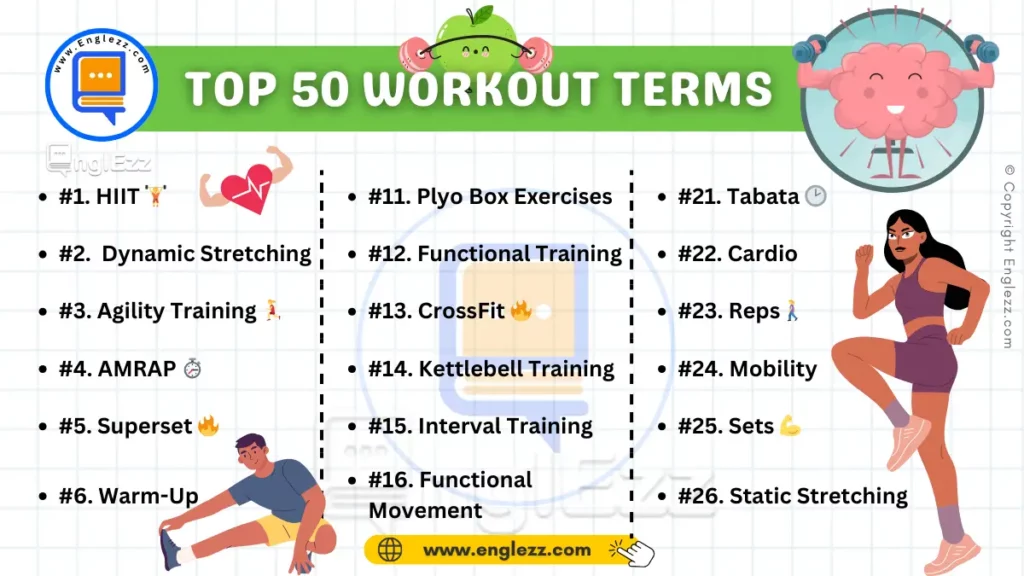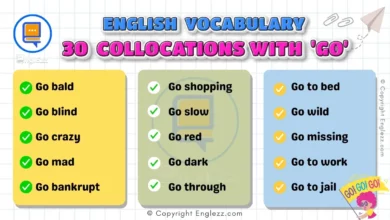Understanding workout English terms is essential for anyone looking to enhance their fitness journey, whether you’re a beginner or an advanced athlete. The language used in fitness and exercise environments can often be confusing, but knowing the correct terminology helps you to follow workouts more effectively, communicate with trainers, and reach your fitness goals. In this blog post, we’ll explore 50 common workout English terms, breaking down their meanings, phonetic transcriptions, and providing practical examples of each term in use.
Table of Contents
- 50 Essential Workout English Terms to Know for Effective Fitness Training
- #1. Reps 🏋️
- #2. Sets 🏆
- #3. Circuit Training 🔄
- #4. Cardio ❤️
- #5. Strength Training 💪
- #6. HIIT 🕒
- #7. Warm-Up 🔥
- #8. Cool-Down ❄️
- #9. Core 🧘
- #10. Flexibility 🧩
- #11. Plyometrics 💥
- #12. Endurance ⏱️
- #13. Resistance Training 🏋️♂️
- #14. Recovery 🛌
- #15. Superset 💥
- #16. Isolation Exercises 🚶♂️
- #17. Compound Exercises 🏋️♀️
- #18. Overload Principle ⚖️
- #19. Burnout 🔥
- #20. Set Point Theory 🧮
- #21. Functional Training 🛠️
- #22. Bodyweight Exercises 💪
- #23. Dynamic Stretching 🚶♀️
- #24. Static Stretching 🧘♀️
- #25. Agility Training 🏃♀️
- #26. Mobility 🏋️
- #27. Plyo Box Exercises 📦
- #28. Tabata 🕑
- #29. CrossFit 🔥
- #30. Kettlebell Training 🔔
- #31. Interval Training ⏱️
- #32. Functional Movement 🏋️
- #33. Strength-to-Weight Ratio 🏋️♀️
- #34. Powerlifting 🏋️♂️
- #35. Endurance Training 🏃
- #36. Speed Work 🚀
- #37. High-Volume Training 📈
- #38. Low-Impact Exercises 🧘♂️
- #39. Rest Intervals ⏳
- #40. Active Recovery 🏃♂️
- #41. Balance Training ⚖️
- #42. Body Composition 🧑🔬
- #43. Isometric Exercises 🧱
- #44. Cross-Training 🔄
- #45. Training Split 🔢
- #46. Maximum Effort 💯
- #47. Compound Sets 🏋️♂️
- #48. HIIT Circuit 🔄
- #49. Drop Sets 🔽
- #50. Recovery Day 🛌
- Workout English Terms Table
- Conclusion
50 Essential Workout English Terms to Know for Effective Fitness Training
Whether you’re looking to understand gym jargon, improve your exercise vocabulary, or simply want to sound like a pro at your next workout session, this guide will provide you with clear definitions and useful examples to get you started.
With these terms at your fingertips, you’ll be well on your way to mastering the language of fitness and making the most out of your exercise routines. Let’s dive into these essential workout terms and get ready to boost your fitness vocabulary!
#1. Reps 🏋️
Definition: Reps, short for repetitions, refer to the number of times you perform a specific exercise or movement.
Phonetic Transcription: /rɛps/
Examples:
- “I did 15 reps of squats in my workout.”
- “The trainer asked us to complete 10 reps of each exercise.”
#2. Sets 🏆
Definition: Sets are groups of repetitions performed consecutively without rest.
Phonetic Transcription: /sɛts/
Examples:
- “She completed 3 sets of push-ups.”
- “After finishing a set, rest for a minute before starting the next one.”
#3. Circuit Training 🔄
Definition: Circuit training involves a series of exercises performed in a sequence with minimal rest between them.
Phonetic Transcription: /ˈsɜːrkɪt ˈtreɪnɪŋ/
Examples:
- “We did a circuit training session with cardio and strength exercises.”
- “Circuit training helps to keep the heart rate up.”
#4. Cardio ❤️
Definition: Cardio, short for cardiovascular exercise, focuses on increasing heart rate and improving heart health.
Phonetic Transcription: /ˈkɑːrdiˌoʊ/
Examples:
- “Running is a great cardio workout.”
- “Cardio exercises help burn calories and improve endurance.”
#5. Strength Training 💪
Definition: Strength training involves exercises that improve muscle strength and endurance through resistance.
Phonetic Transcription: /strɛŋkθ ˈtreɪnɪŋ/
Examples:
- “Lifting weights is a form of strength training.”
- “Strength training helps to build muscle mass.”
#6. HIIT 🕒
Definition: High-Intensity Interval Training (HIIT) alternates between short bursts of intense exercise and rest periods.
Phonetic Transcription: /ˈhaɪ ˌɪnˈtɛnʃɪv ˈɪntəˌvəl ˈtreɪnɪŋ/
Examples:
- “HIIT workouts are effective for burning fat quickly.”
- “She prefers HIIT for a quick, high-energy session.”
#7. Warm-Up 🔥
Definition: A warm-up consists of low-intensity exercises performed before a workout to prepare the body.
Phonetic Transcription: /wɔːrm ʌp/
Examples:
- “Always start with a warm-up to prevent injury.”
- “A good warm-up can include stretching and light cardio.”

#8. Cool-Down ❄️
Definition: A cool-down involves exercises performed at a lower intensity to help the body recover after a workout.
Phonetic Transcription: /kuːl daʊn/
Examples:
- “Finish your workout with a cool-down to help muscles relax.”
- “The cool-down phase included stretching and slow jogging.”
#9. Core 🧘
Definition: Core exercises target the muscles in the abdomen, lower back, and hips.
Phonetic Transcription: /kɔːr/
Examples:
- “Planks are excellent for core strengthening.”
- “A strong core helps improve overall stability and posture.”
#10. Flexibility 🧩
Definition: Flexibility refers to the range of motion around a joint or muscle.
Phonetic Transcription: /flɛksɪˈbɪləti/
Examples:
- “Yoga enhances flexibility and balance.”
- “Improving flexibility can help reduce the risk of injury.”
#11. Plyometrics 💥
Definition: Plyometrics are explosive exercises designed to increase power and strength.
Phonetic Transcription: /ˌplaɪəˈmɛtrɪks/
Examples:
- “Jump squats are a common plyometric exercise.”
- “Plyometrics are great for developing explosive strength.”
#12. Endurance ⏱️
Definition: Endurance is the ability to sustain prolonged physical activity.
Phonetic Transcription: /ɪnˈdʊərəns/
Examples:
- “Running long distances builds cardiovascular endurance.”
- “Endurance training can involve activities like cycling and swimming.”
#13. Resistance Training 🏋️♂️
Definition: Resistance training uses resistance to build muscle strength and endurance.
Phonetic Transcription: /rɪˈzɪstəns ˈtreɪnɪŋ/
Examples:
- “Using resistance bands can enhance your workout.”
- “Resistance training can include exercises like bicep curls.”
#14. Recovery 🛌
Definition: Recovery is the period of rest and repair following intense exercise.
Phonetic Transcription: /rɪˈkʌvəri/
Examples:
- “Proper recovery helps prevent overtraining and injuries.”
- Incorporate rest days into your routine for effective recovery.
#15. Superset 💥
Definition: A superset involves performing two exercises back-to-back with no rest in between.
Phonetic Transcription: /ˈsuːpəˌsɛt/
Examples:
- “Combine bicep curls and tricep extensions in a superset.”
- Supersets increase workout intensity and save time.”
#16. Isolation Exercises 🚶♂️
Definition: Isolation exercises target a single muscle group for focused strength training.
Phonetic Transcription: /ˌaɪsəˈleɪʃən ˈɛksəˌsaɪzɪz/
Examples:
- Bicep curls are an example of an isolation exercise.”
- “Isolation exercises are great for improving muscle definition.”
#17. Compound Exercises 🏋️♀️
Definition: Compound exercises work multiple muscle groups at once.
Phonetic Transcription: /ˈkɒmpaʊnd ˈɛksəˌsaɪzɪz/
Examples:
- “Squats are a compound exercise that targets the legs and core.”
- “Deadlifts work several muscle groups including the back and legs.”
#18. Overload Principle ⚖️
Definition: The overload principle states that to improve strength, you must increase the resistance or intensity of your workouts.
Phonetic Transcription: /ˈoʊvərˌloʊd ˈprɪnsəpl/
Examples:
- “Gradually increasing weights follows the overload principle.”
- “To build muscle, apply the overload principle to your exercises.”
#19. Burnout 🔥
Definition: Burnout refers to reaching muscle fatigue where no additional repetitions can be performed.
Phonetic Transcription: /ˈbɜːrnaʊt/
Examples:
- “Performing an exercise until burnout helps increase muscle strength.”
- “Include burnout sets in your routine for maximum muscle activation.”
#20. Set Point Theory 🧮
Definition: Set Point Theory suggests that each individual has a weight range they naturally maintain.
Phonetic Transcription: /sɛt pɔɪnt ˈθɪəri/
Examples:
- “Set Point Theory explains why it’s hard to lose weight permanently.”
- “Understanding Set Point Theory can help with weight management strategies.
#21. Functional Training 🛠️
Definition: Functional training focuses on exercises that improve daily life movements and activities.
Phonetic Transcription: /ˈfʌŋkʃənl ˈtreɪnɪŋ/
Examples:
- “Functional training can include movements like squatting and lifting.”
- “This type of training improves overall movement efficiency and strength.”
#22. Bodyweight Exercises 💪
Definition: Bodyweight exercises use the individual’s body weight as resistance.
Phonetic Transcription: /ˈbɒdiweɪt ˈɛksəˌsaɪzɪz/
Examples:
- “Push-ups and squats are popular bodyweight exercises.”
- “Bodyweight exercises are convenient for at-home workouts.”
#23. Dynamic Stretching 🚶♀️
Definition: Dynamic stretching involves moving parts of your body through their full range of motion.
Phonetic Transcription: /daɪˈnæmɪk ˈstrɛtʃɪŋ/
Examples:
- “Leg swings are an example of dynamic stretching.”
- “Dynamic stretching prepares your muscles for more intense exercise.”
#24. Static Stretching 🧘♀️
Definition: Static stretching involves holding a stretch for a period of time to improve flexibility.
Phonetic Transcription: /ˈstætɪk ˈstrɛtʃɪŋ/
Examples:
- “Hold a hamstring stretch for 30 seconds for better flexibility.”
- “Static stretching is usually performed after a workout.”
#25. Agility Training 🏃♀️
Definition: Agility training enhances the ability to move quickly and change direction efficiently.
Phonetic Transcription: /əˈdʒɪləti ˈtreɪnɪŋ/
Examples:
- “Agility drills like ladder exercises improve speed and coordination.”
- “Agility training is important for sports that require quick movements.”
#26. Mobility 🏋️
Definition: Mobility refers to the ability to move a joint or muscle through its full range of motion.
Phonetic Transcription: /məʊˈbɪləti/
Examples:
- Incorporate mobility exercises to enhance joint function.
- “Good mobility helps prevent injuries during workouts.”
#27. Plyo Box Exercises 📦
Definition: Plyo box exercises involve jumping onto or off a box to build explosive power.
Phonetic Transcription: /ˈplaɪoʊ bɒks ˈɛksəˌsaɪzɪz/
Examples:
- “Box jumps are a common plyo box exercise.”
- “Plyo box exercises enhance leg strength and agility.”
#28. Tabata 🕑
Definition: Tabata is a form of HIIT involving 20 seconds of intense exercise followed by 10 seconds of rest, repeated for 4 minutes.
Phonetic Transcription: /təˈbɑːtə/
Examples:
- “A Tabata workout can include burpees and squats.”
- “Tabata training is effective for improving both strength and cardio.”
#29. CrossFit 🔥
Definition: CrossFit is a high-intensity workout regime combining elements of weightlifting, cardio, and functional movements.
Phonetic Transcription: /ˈkrɒsˌfɪt/
Examples:
- “CrossFit workouts often include varied exercises and high intensity.”
- “Join a CrossFit class for a challenging and dynamic workout experience.”
#30. Kettlebell Training 🔔
Definition: Kettlebell training uses kettlebells to improve strength, power, and endurance.
Phonetic Transcription: /ˈkɛtəlˌbɛl ˈtreɪnɪŋ/
Examples:
- “Swings and snatches are popular kettlebell exercises.”
- “Kettlebell training enhances functional strength and stability.”
#31. Interval Training ⏱️
Definition: Interval training alternates between periods of high-intensity exercise and lower-intensity recovery.
Phonetic Transcription: /ˈɪntəvəl ˈtreɪnɪŋ/
Examples:
- “Run at full speed for 1 minute, then walk for 2 minutes in interval training.”
- “Interval training boosts cardiovascular fitness and burns fat.”
#32. Functional Movement 🏋️
Definition: Functional movement exercises replicate everyday actions to improve overall physical function.
Phonetic Transcription: /ˈfʌŋkʃənl ˈmuːvmənt/
Examples:
- “Exercises like lunges and squats are functional movements.”
- “Functional movement training enhances daily activities and balance.”
#33. Strength-to-Weight Ratio 🏋️♀️
Definition: The strength-to-weight ratio measures how much strength a person has relative to their body weight.
Phonetic Transcription: /strɛŋkθ tə weɪt ˈreɪʃioʊ/
Examples:
- “Athletes often aim to improve their strength-to-weight ratio.”
- “A higher strength-to-weight ratio can enhance performance in bodyweight exercises.”
#34. Powerlifting 🏋️♂️
Definition: Powerlifting focuses on lifting the maximum weight in three key lifts: squat, bench press, and deadlift.
Phonetic Transcription: /ˈpaʊərˌlɪftɪŋ/
Examples:
- “Powerlifting competitions involve testing your max squat, bench, and deadlift.”
- “Powerlifting builds raw strength and muscle mass.”
#35. Endurance Training 🏃
Definition: Endurance training focuses on increasing the ability to sustain prolonged physical activity.
Phonetic Transcription: /ɪnˈdʊərəns ˈtreɪnɪŋ/
Examples:
- “Long-distance running is a form of endurance training.”
- “Endurance training helps improve stamina and overall fitness.”
#36. Speed Work 🚀
Definition: Speed work involves exercises aimed at improving running speed and agility.
Phonetic Transcription: /spiːd wɜːrk/
Examples:
- “Incorporate interval sprints into your speed work routine.”
- “Speed work is essential for athletes looking to improve their race times.”
#37. High-Volume Training 📈
Definition: High-volume training involves performing a large number of sets and reps to stimulate muscle growth.
Phonetic Transcription: /haɪ ˈvɒljum ˈtreɪnɪŋ/
Examples:
- “Bodybuilders often use high-volume training for muscle hypertrophy.”
- “High-volume training can lead to increased muscle endurance and size.”
#38. Low-Impact Exercises 🧘♂️
Definition: Low-impact exercises are gentle on the joints while still providing effective workouts.
Phonetic Transcription: /loʊ ˈɪmpækt ˈɛksəˌsaɪzɪz/
Examples:
- “Swimming and cycling are examples of low-impact exercises.”
- “Low-impact exercises are suitable for people with joint issues.”
#39. Rest Intervals ⏳
Definition: Rest intervals are short breaks taken between sets or exercises to allow the body to recover.
Phonetic Transcription: /rɛst ˈɪntərvəlz/
Examples:
- “Take a 60-second rest interval between sets of weightlifting.”
- Adjust rest intervals based on your fitness goals and intensity.”
#40. Active Recovery 🏃♂️
Definition: Active recovery involves low-intensity exercises performed during rest periods to promote muscle recovery.
Phonetic Transcription: /ˈæktɪv rɪˈkʌvəri/
Examples:
- “Gentle stretching or light jogging can be part of active recovery.”
- “Active recovery helps reduce muscle soreness and improve circulation.”
#41. Balance Training ⚖️
Definition: Balance training focuses on improving stability and coordination through various exercises.
Phonetic Transcription: /ˈbælənθ ˈtreɪnɪŋ/
Examples:
- “Balance boards and stability balls are used in balance training.”
- “Good balance training can help prevent falls and injuries.”
#42. Body Composition 🧑🔬
Definition: Body composition refers to the ratio of fat, muscle, and other tissues in the body.
Phonetic Transcription: /ˈbɒdi kɒmpəˈzɪʃən/
Examples:
- “Measuring body composition helps track changes in muscle and fat.”
- Body composition assessments are useful for setting fitness goals.
#43. Isometric Exercises 🧱
Definition: Isometric exercises involve contracting muscles without changing their length or moving the joint.
Phonetic Transcription: /ˌaɪsəˈmɛtrɪk ˈɛksəˌsaɪzɪz/
Examples:
- “Planks are a common isometric exercise.”
- “Isometric exercises are useful for building strength and stability.”
#44. Cross-Training 🔄
Definition: Cross-training involves incorporating different types of exercise to improve overall fitness and prevent monotony.
Phonetic Transcription: /krɒs ˈtreɪnɪŋ/
Examples:
- “A runner might include swimming and cycling in their cross-training routine.”
- “Cross-training helps balance muscle development and reduces the risk of injury.”
#45. Training Split 🔢
Definition: A training split divides workout routines into different muscle groups or exercises on different days.
Phonetic Transcription: /ˈtreɪnɪŋ splɪt/
Examples:
- “A common training split includes upper body on one day and lower body on another.”
- “Training splits allow for focused muscle group recovery.”
#46. Maximum Effort 💯
Definition: Maximum effort refers to putting forth the highest level of intensity or exertion in an exercise.
Phonetic Transcription: /ˈmækˌsɪməm ˈɛfərt/
Examples:
- “Push yourself to maximum effort during interval sprints.”
- “Maximum effort is crucial for reaching peak performance levels.”
#47. Compound Sets 🏋️♂️
Definition: Compound sets involve performing two exercises for the same muscle group consecutively without rest.
Phonetic Transcription: /ˈkɒmpaʊnd sɛts/
Examples:
- “Try a compound set of bench presses followed by dumbbell flies.”
- “Compound sets intensify your workout and target muscles more effectively.”
#48. HIIT Circuit 🔄
Definition: A HIIT circuit combines high-intensity interval training with a series of exercises performed in sequence.
Phonetic Transcription: /ˈhaɪ ˌɪnˈtɛnʃən ˈɪntəˌvəl ˈsɜːrkɪt/
Examples:
- “In a HIIT circuit, you might alternate between burpees, squats, and lunges.”
- “HIIT circuits are effective for full-body workouts and fat burning.”
#49. Drop Sets 🔽
Definition: Drop sets involve performing an exercise to failure, then reducing the weight and continuing for additional reps.
Phonetic Transcription: /drɒp sɛts/
Examples:
- “Drop sets help push muscles beyond their normal fatigue point.”
- “Incorporate drop sets to enhance muscle growth and endurance.”
#50. Recovery Day 🛌
Definition: A recovery day is a designated day of rest or low-intensity exercise to allow the body to recover from previous workouts.
Phonetic Transcription: /rɪˈkʌvəri deɪ/
Examples:
- “Take a recovery day after several intense workout sessions.”
- “Active recovery days can include light activities like walking or stretching.”
Workout English Terms Table
Incorporating a diverse range of workout terms and techniques into your fitness routine can significantly enhance your training effectiveness and overall health. Understanding concepts like High-Intensity Interval Training (HIIT), Bodyweight Exercises, and Plyo Box Exercises allows you to tailor your workouts to meet specific goals, whether it’s building strength, improving endurance, or enhancing agility.
| #1. HIIT 🏋️ | #11. Plyo Box Exercises 📦 | #21. Functional Training 🛠️ |
| #2. Reps 🔁 | #12. Tabata 🕑 | #22. Bodyweight Exercises 💪 |
| #3. Sets 💪 | #13. CrossFit 🔥 | #23. Dynamic Stretching 🚶♀️ |
| #4. AMRAP ⏱️ | #14. Kettlebell Training 🔔 | #24. Static Stretching 🧘♀️ |
| #5. Superset 🔥 | #15. Interval Training ⏱️ | #25. Agility Training 🏃♀️ |
| #6. Warm-Up 🌡️ | #16. Functional Movement 🏋️ | #26. Mobility 🏋️ |
| #7. Cool-Down ❄️ | #17. Strength-to-Weight Ratio 🏋️♀️ | #27. Powerlifting 🏋️♂️ |
| #8. Cardio ❤️ | #18. Endurance Training 🏃 | #28. Speed Work 🚀 |
| #9. Recovery 💆♂️ | #19. High-Volume Training 📈 | #29. Cross-Training 🔄 |
| #10. Flexibility 🤸 | #20. Low-Impact Exercises 🧘♂️ | #30. Training Split 🔢 |
Each term and technique, from Functional Training to Recovery Days, plays a vital role in crafting a balanced exercise regimen that promotes physical well-being and fitness progression.
Conclusion
Mastering workout English terms not only enhances your ability to follow exercise routines but also empowers you to communicate effectively within the fitness community. By familiarizing yourself with these 50 key terms, you gain confidence in your fitness vocabulary and improve your overall workout experience.
Whether you’re discussing exercises with a trainer, joining group fitness classes, or simply trying to follow along with online workouts, understanding these terms is crucial for achieving your fitness goals. We hope this guide has provided valuable insights and clarity on common workout terms.
Keep practicing and incorporating these terms into your routine, and you’ll find yourself more adept at navigating the world of fitness. Continue expanding your fitness knowledge and stay motivated on your journey to better health and performance.









Ready to level up your fitness game? Discover 50 essential workout English terms that can transform your training routine! 💪 Dive into our latest post and get to know key concepts like HIIT, Plyo Box Exercises, and more. Follow and like @EnglEzz for more insightful content! Stay ahead in your fitness journey. 🌟 Check it out now at
.
https://www.englezz.com/50-essential-workout-english-terms-to-know/
.
#englezz #vocabulary #linguistics #fitness #workout #training #health #exercise #wellness